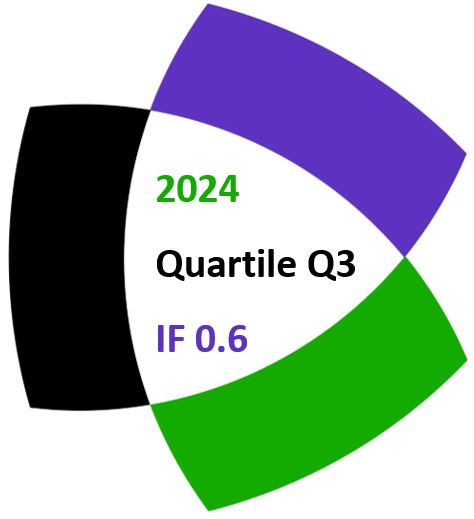Ömür Deveci, Zafer Adıgüzel and Taha Doğan
Notes on Number Theory and Discrete Mathematics
Print ISSN 1310–5132, Online ISSN 2367–8275
Volume 26, 2020, Number 1, Pages 179-190
DOI: 10.7546/nntdm.2020.26.1.179-190
Full paper (PDF, 182 Kb)
Details
Authors and affiliations
Ömür Deveci ![]()
Department of Mathematics, Faculty of Science and Letters
Kafkas University, 36100, Turkey
Zafer Adıgüzel ![]()
Department of Mathematics, Faculty of Science and Letters
Kafkas University, 36100, Turkey
Taha Doğan ![]()
Department of Mathematics, Faculty of Science and Letters
Kafkas University, 36100, Turkey
Abstract
The theory of Fibonacci-circulant numbers was introduced by Deveci et al. (see [5]).
In this paper, we define the Fibonacci-circulant-Hurwitz sequence of the second kind by Hurwitz matrix of the generating function of the Fibonacci-circulant sequence of the second kind and give a fair generalization of the sequence defined, which we call the generalized Fibonacci-circulant-Hurwitz sequence. First, we derive relationships between the generalized Fibonacci-circulant-Hurwitz numbers and the generating matrices for these numbers. Also, we give miscellaneous properties of the generalized Fibonacci-circulant-Hurwitz numbers such as the Binet formula, the combinatorial, permanental, determinantal representations, the generating function, the exponential representation and the sums.
Keywords
- Fibonacci-circulant-Hurwitz Sequence
- Circulant matrix
- Hurwitz matrix
- Representation
2010 Mathematics Subject Classification
- 11K31
- 11B50
- 11C20
- 20D60
References
- Atanassov, K. T., Atanassova, V. K., Shannon, A. G., & Turner, J. (2002). New Visual Perspectives on Fibonacci Numbers, World Scientific.
- Brualdi, R. A., & Gibson, P. M. (1997). Convex polyhedra of doubly stochastic matrices I: applications of permanent function, J. Combin. Theory, 22, 194–230.
- Chen, W. Y. C., & Louck, J. C. (1996). The combinatorial power of the companion matrix, Linear Algebra Appl., 232, 261–278.
- Deveci, O. (2018). On the Fibonacci-circulant p-sequences, Util Math., 108, 107–124.
- Deveci, O., Karaduman, E., & Campbell, C. M. (2017). The Fibonacci-circulant sequences and their applications, Iran J. Sci. Technol. Trans. Sci., 41 (4), 1033–1038.
- El Naschie, M. S. (2005). Deriving the essential features of standard model from the general theory of relativity, Chaos Solitons Fractals, 24 (4), 941–946.
- Gogin, N. D., & Myllari, A. A. (2007). The Fibonacci–Padovan sequence and MacWilliams transform matrices, Program. Comput Softw published in Programmirovanie, 33 (2), 74–79.
- Hurwitz, A. (1895). Ueber die Bedingungen unter welchen eine gleichung nur Wurzeln mit negative reellen teilen besitzt, Mathematische Annalen, 46, 273–284.
- Kalman, D. (1982). Generalized Fibonacci numbers by matrix methods, Fibonacci Quart., 20 (1), 73–76.
- Kaluge, G. R. (2011). Penggunaan Fibonacci dan Josephus problem dalam algoritma enkripsi transposisi+substitusi, Makalah IF 3058 Kriptografi-Sem. II Tahun.
- Kilic, E. (2008). The Binet formula, sums and representations of generalized Fibonacci p-numbers, European J. Combin, 29, 701–711.
- Kilic, E., & Tasci, D. (2007). On the permanents of some tridiagonal matrices with applications to the Fibonacci and Lucas numbers, Rocky Mountain J. Math., 37 (6), 1953–1969.
- Kirchoof, B. K., & Rutishauser, R. (1990). The phyllotaxy of costus (costaceae), Bot Gazette, 151 (1), 88–105.
- Kraus, F. J., Mansour, M., & Sebek, M. (1996). Hurwitz Matrix for Polynomial Matrices, In Jeltsch R Mansour M (eds) Stability Theory ISNM International Series of Numerical Mathematics 121 Birkhäuser Basel.
- Lancaster, P., & Tismenesky, M. (1985). The Theory of Matrices, Academic Press.
- Lidl, R., & Niederreiter, H. (1986). Introduction to Finite Fields and Their Applications, Cambridge UP.
- Lipshitz, L., & van der, A. (1990). Poorten AJ Rational functions, diagonals, automata and arithmetic, Number Theory (Banff, AB, 1988) de Grutyer, Berlin, 339–358.
- Mandelbaum, D. M. (1972). Synchronization of codes by means of Kautz’s Fibonacci encoding, IEEE Transactions on Information Theory, 18 (2), 281–285.
- Matiyasevich, Y. V. (1993). Hilbert’s Tenth Problem, MIT Press, Cambridge, MA.
- Shannon, A. G., & Leyendekkers, J.V. (2011). Pythagorean Fibonacci patterns, Int. J. Math. Educ. Sci. Technol., 43 (4), 554–559.
- Sloane, N. J. A. Sequences A000045/M0692, A000073/M1074, A000078/M1108, A001591, A001622, A046698, A058265, A086088, and A118745 in The On-Line Encyclopedia of Integer Sequences.
- Spinadel, V.W. (1999). The family of metallic means, Vis Math, 1(3) Mathematical Institute SASA.
- Stakhov, A. P., & Rozin, B. (2006). Theory of Binet formulas for Fibonacci and Lucas p-numbers, Chaos Solitons Fractals, 27 (5), 1162–1167.
- Stein, W. (1993). Modelling the evolution of Stelar architecture in Vascular plants, Int. J. Plant. Sci., 154 (2), 229–263.
- Stewart, I. (1996). Tales of neglected number, Sci. Amer., 274, 102–103.
- Stroeker, R. J. (1988). Brocard Points, Circulant Matrices, and Descartes Folium, Math. Mag., 61 (3), 172–187.
- Tasci, D., & Firengiz, M. C. (2010). Incomplete Fibonacci and Lucas p-numbers, Math. Comput. Modelling, 52, 1763–1770.
- Tuglu, N., Kocer, E. G., & Stakhov, A. P. (2011). Bivariate Fibonacci-like p-polynomials, Appl. Math. Comput., 217 (24), 10239–10246.
- Wolfram Research, (2014). Inc Mathematica, Version 10.0: Champaign, Illinois.
Related papers
Cite this paper
Deveci, Ö., Adıgüzel, Z., & Doğan, T. (2020). On the Generalized Fibonacci-circulant-Hurwitz numbers. Notes on Number Theory and Discrete Mathematics, 26(1), 179-190, DOI: 10.7546/nntdm.2020.26.1.179-190.


